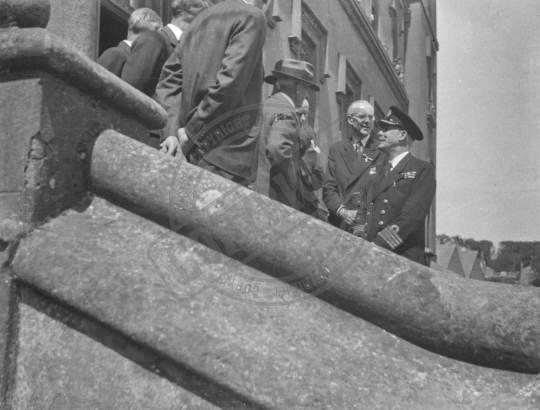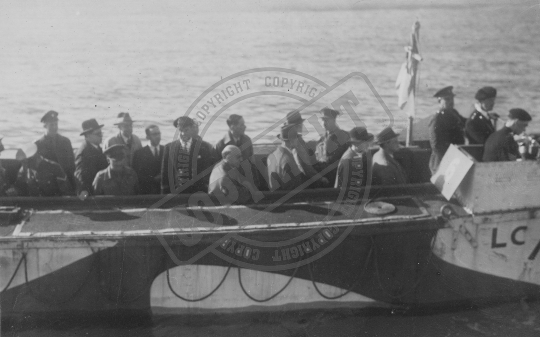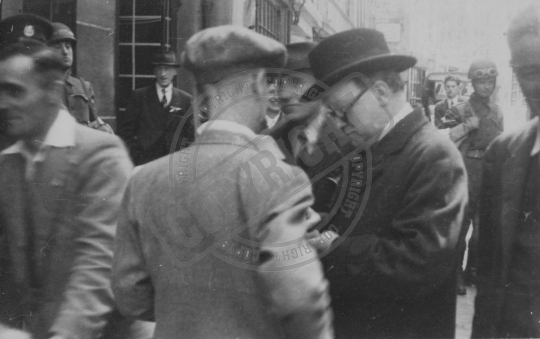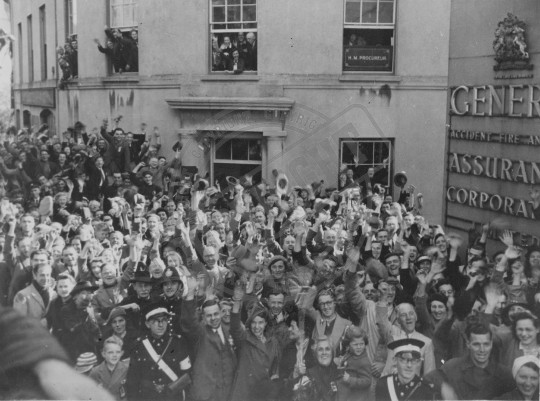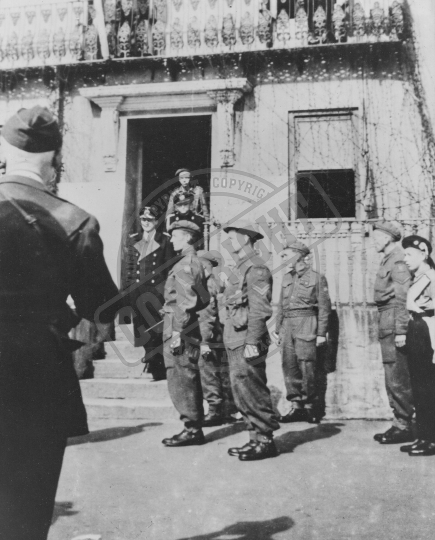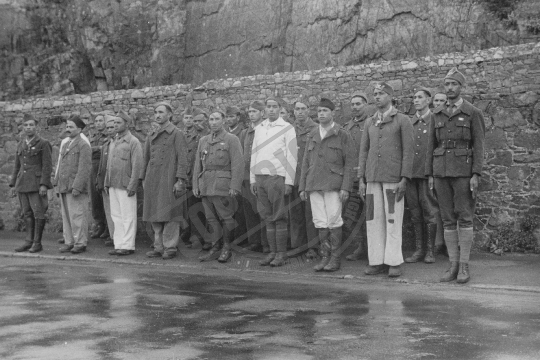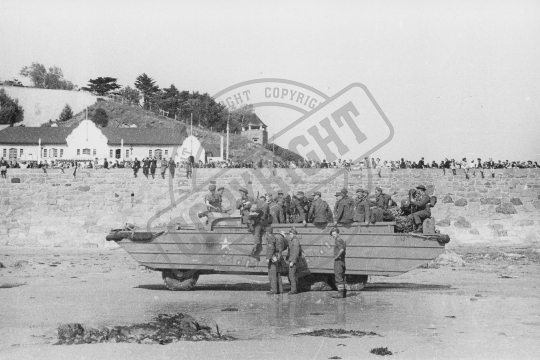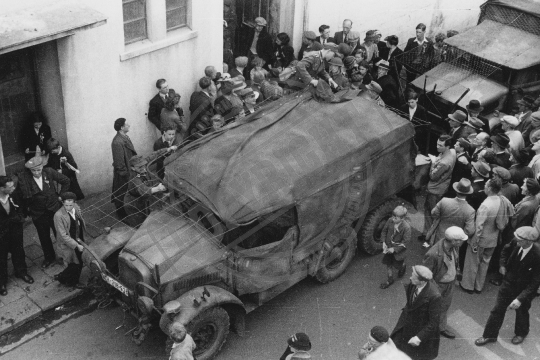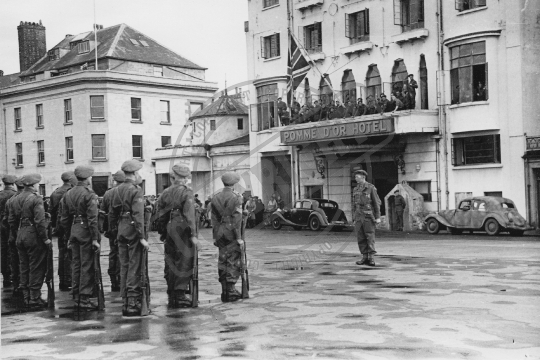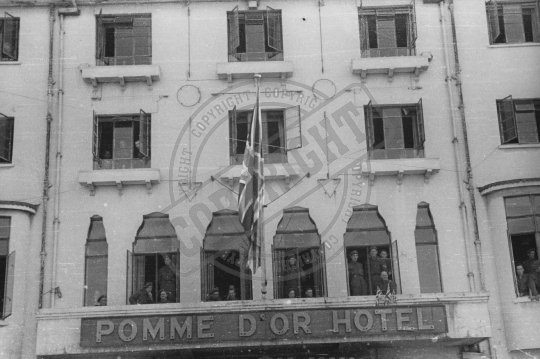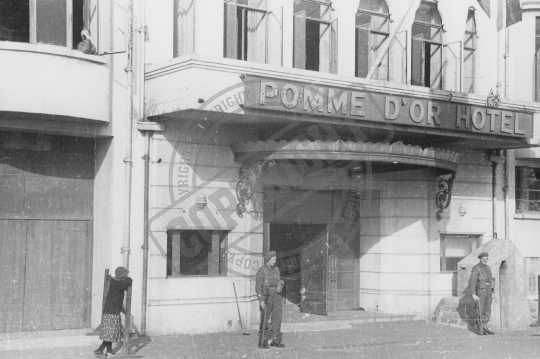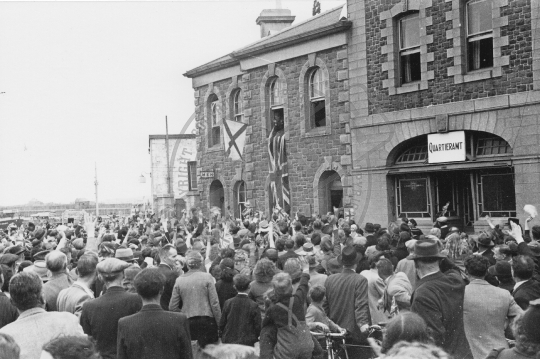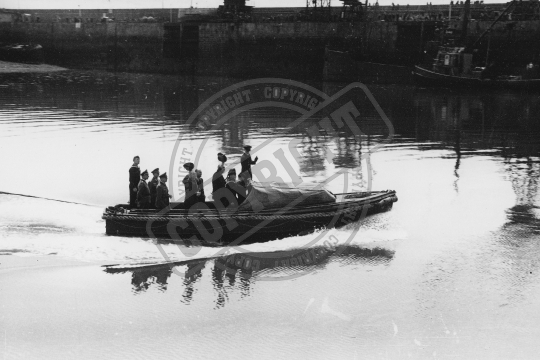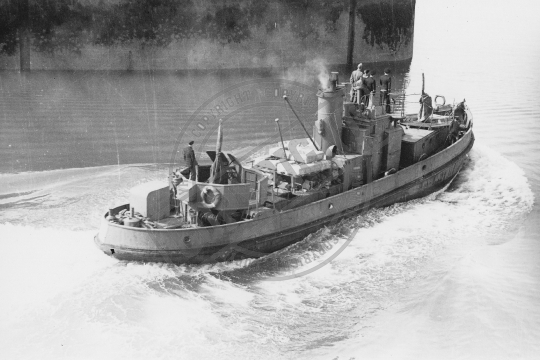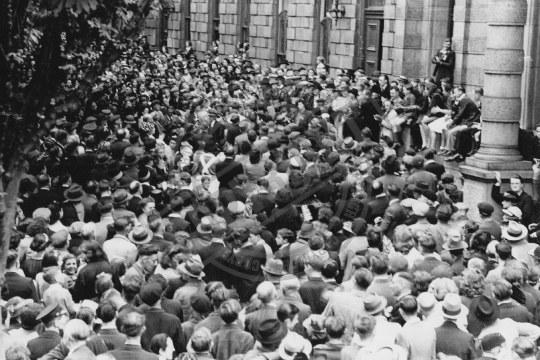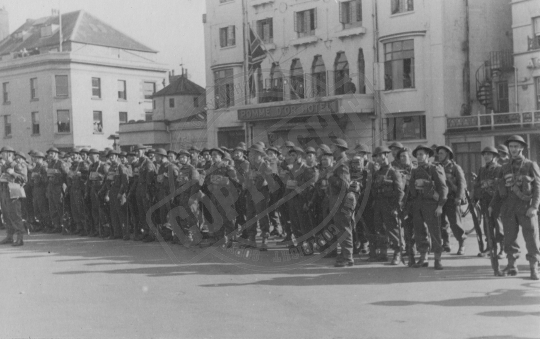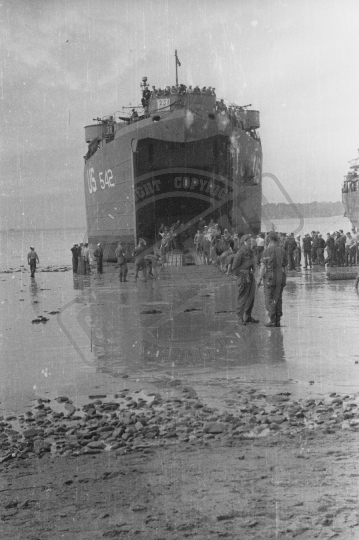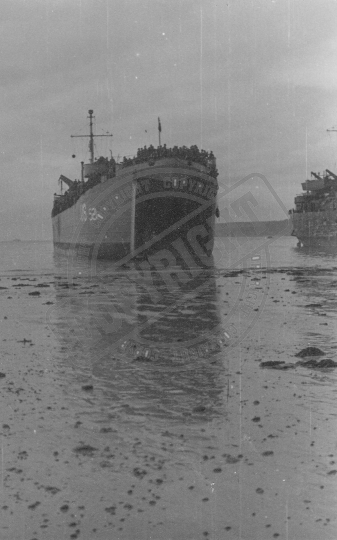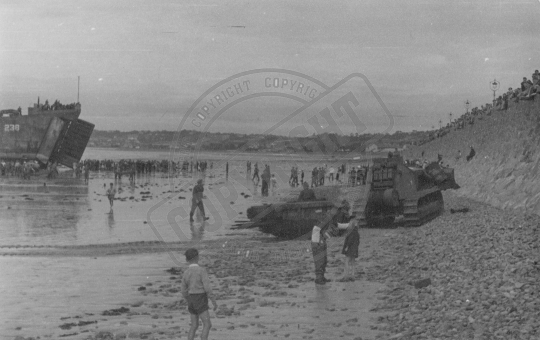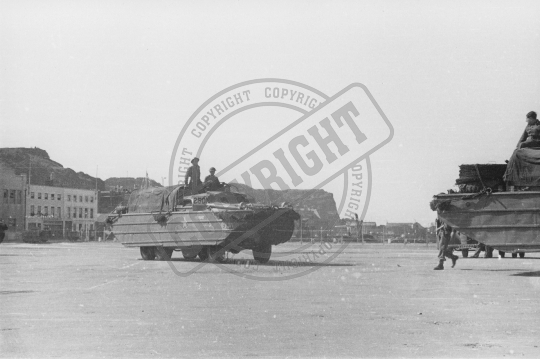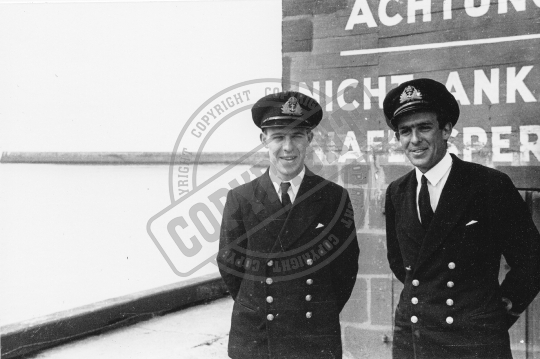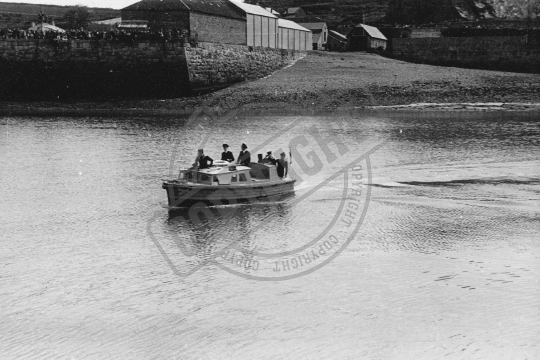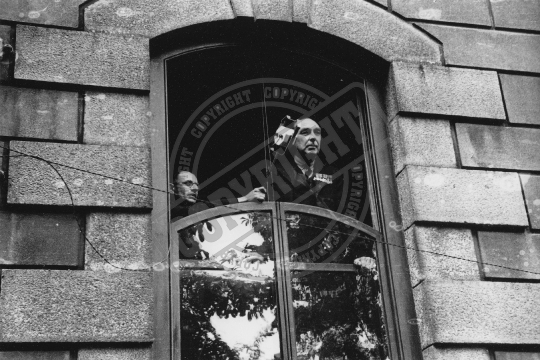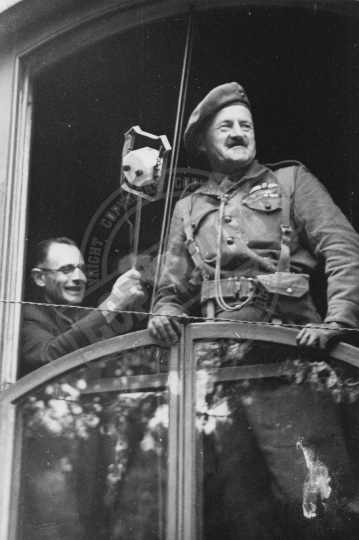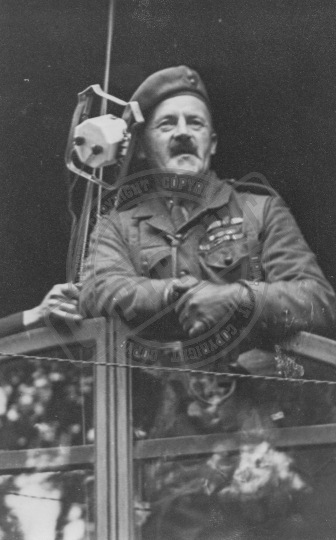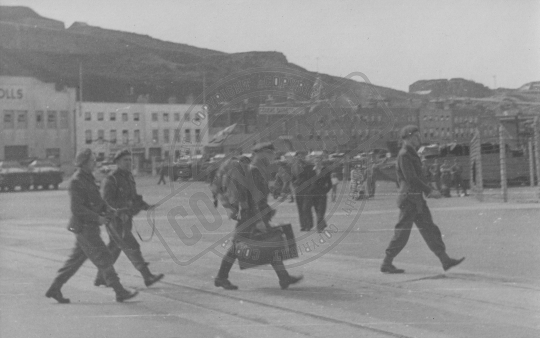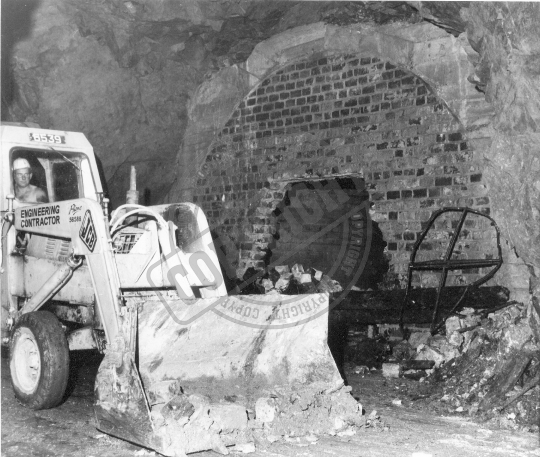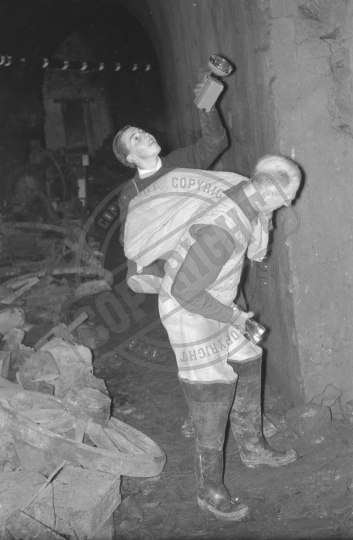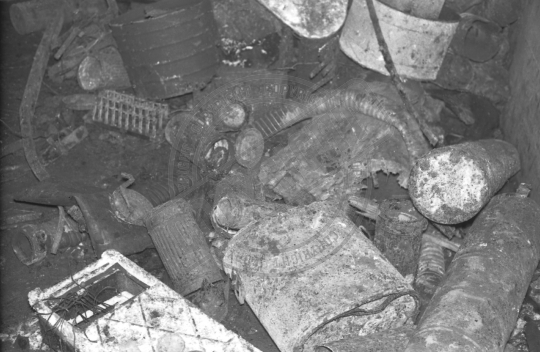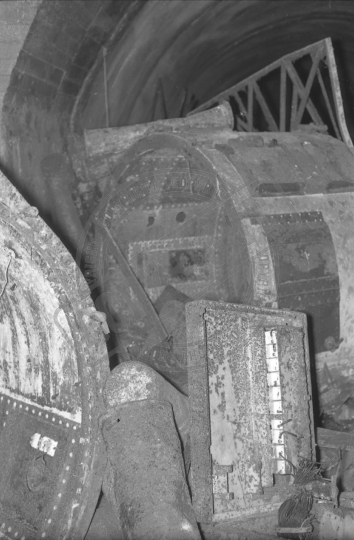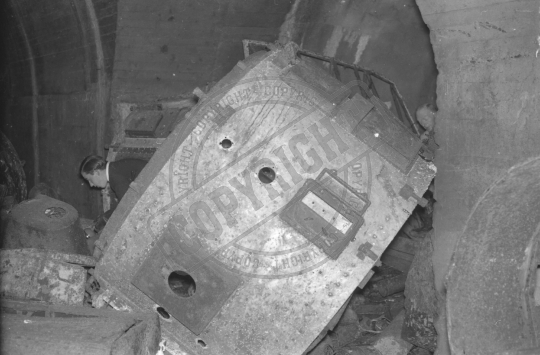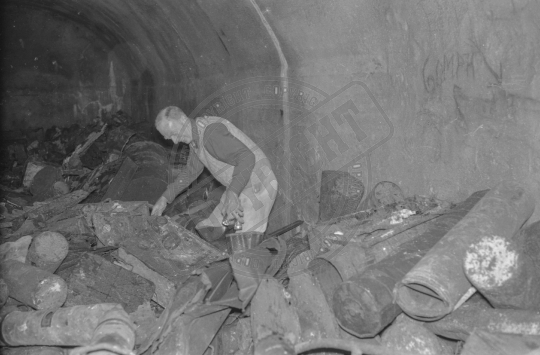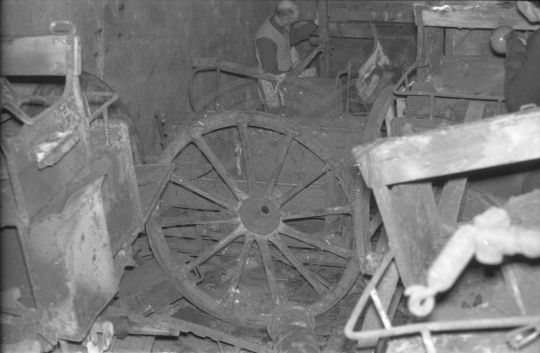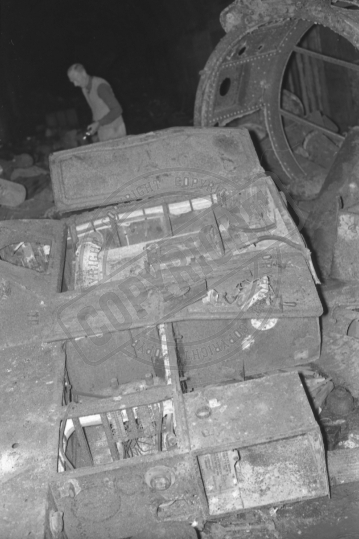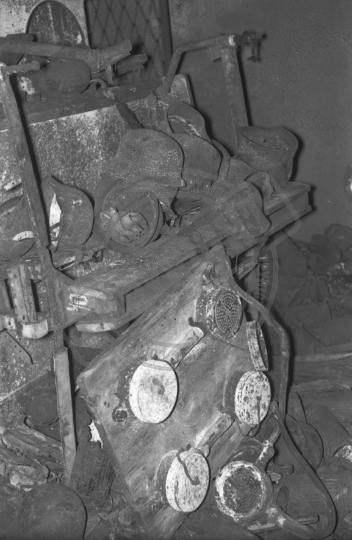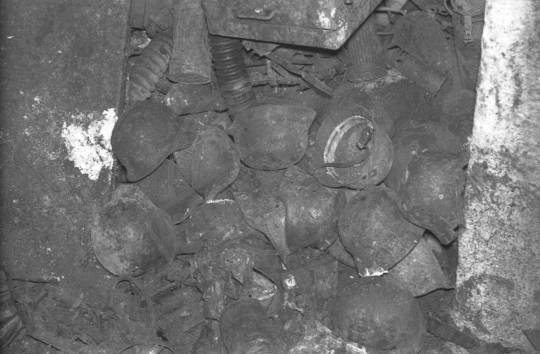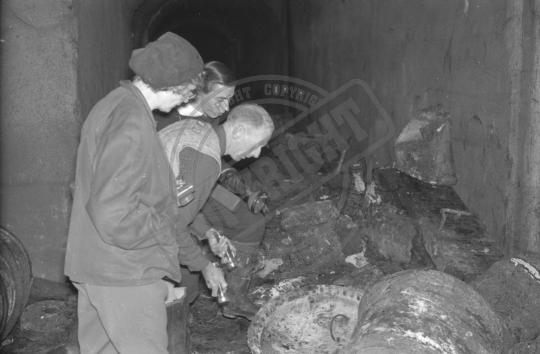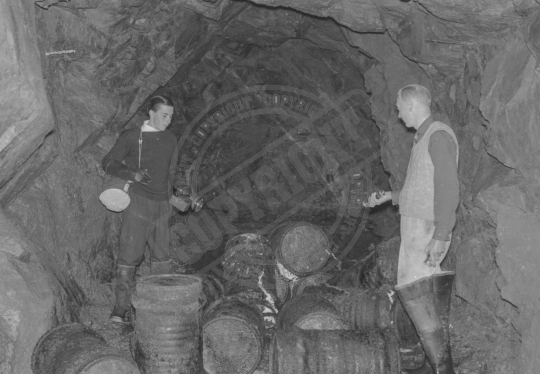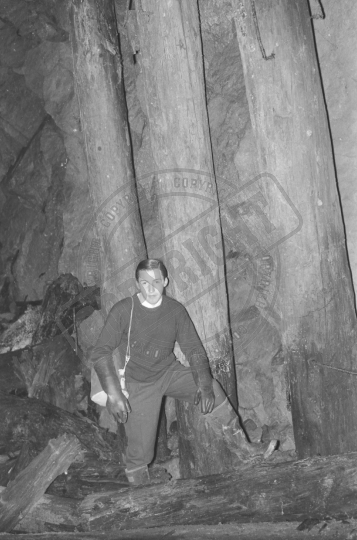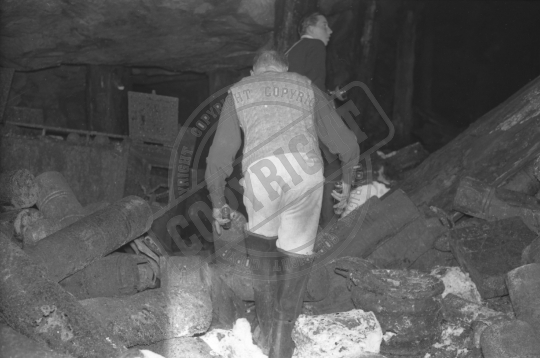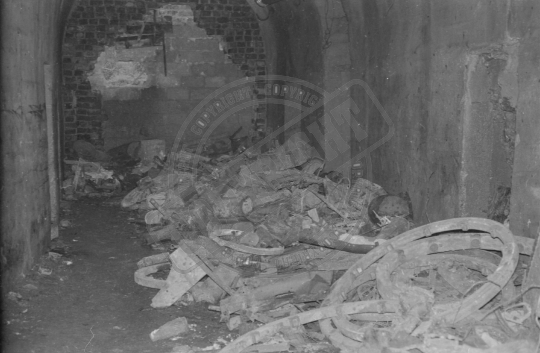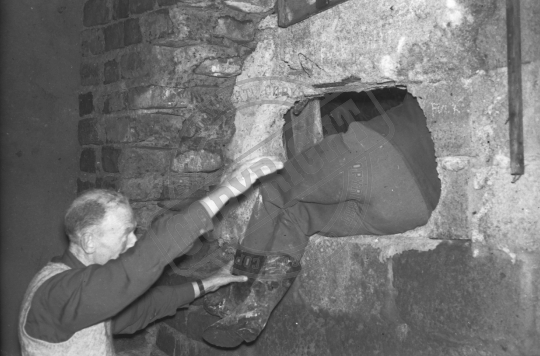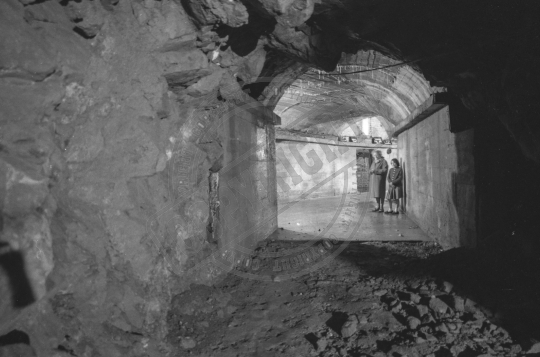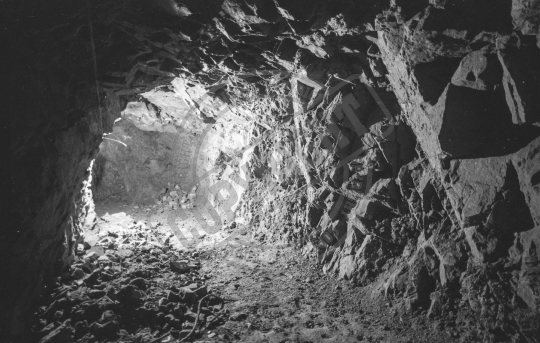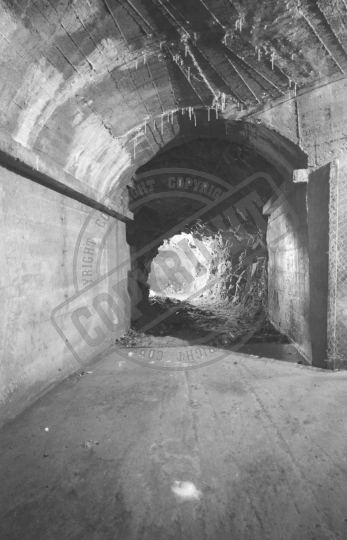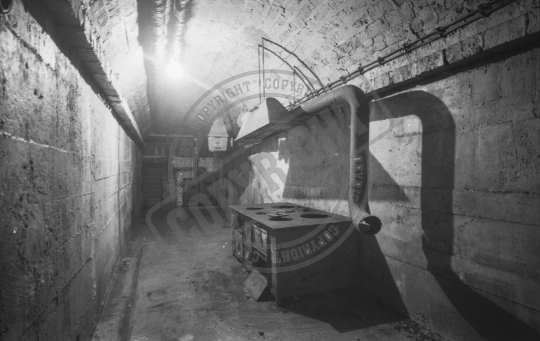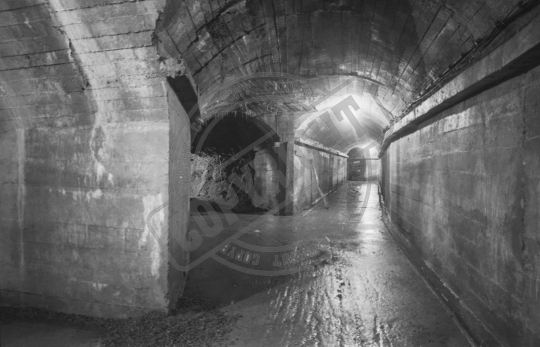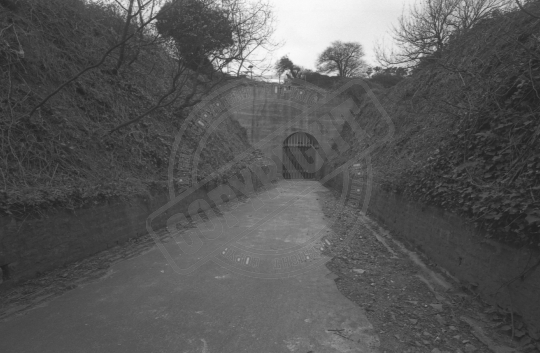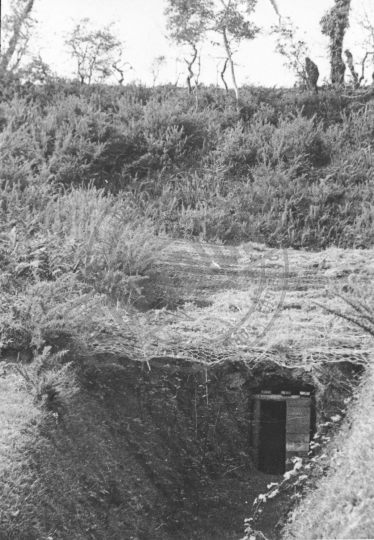Results (364)
OA_015
Rear-Admiral C. G. Stuart, DSO, DSC (serving in the rank of Captain, RN), Naval Commander Force 135, talking to members of the States of Guernsey Controlling Committee on the terrace steps at Elizabeth College, following the reading of the Proclamation on Saturday afternoon 12th May 1945.
OA_012
After his brief visit to Guernsey the Home Secretary and his party were ferried out to the destroyer, Impulsive. Their next destination was Jersey. On board the landing Craft Assault (LCA) can be seen Captain Colvin, Brigadier Snow, Major Le Patourel, Mr. Herbert Morrison, Lord Munster and other British Government Officials.
OA_010
The Home Secretary, the Right Honourable Herbert Stanley Morrison, signing autographs in St Peter Port during his visit to Guernsey on Monday, 14th May, 1945.
OA_003
The crowds in front of the Court House burst into singing the National Anthem as they witnessed the Hoisting of the Union Flag, on the 9th May, 1945. God save the King rang out over St Peter Port, followed by a thunderous outburst of sustained cheering.
OA_002
Brigadier Snow accepted the formal surrender of the German Garrison from Vizeadmiral Hüffmeier at 11.00 hours on Saturday, 12th May, at the former German Naval Headquarters, the Crown Hotel, St Peter Port. He is seen here leaving the Hotel with his ADC, Oberleutnant Edwald Severing. Hüffmeier was escorted to the harbour for evacuation to England. On the left of the photograph, with his back to the camera, is a War Correspondent from the PR Section of Force 135. Note the barbed wire that has been draped from the balcony to the railings.
CIMM_0036
Recently liberated Algerian POWs stand at Pier Road, Jersey on the 24th May 1945 prior to the Empire Day parade. Note the assortment of uniforms.
CIMM_0035
From the 13th to the 19th May, 1945 the majority of the German garrison were evacuated to POW camps in the UK. Here, German POWs are driven down to West Park, Jersey by DUKW.
CIMM_0033
A hive of activity taking place at the side door of the Pomme d 'Or Hotel in Conway Street, Jersey. German prisoners are guarded by British troops. The vehicles are a Morris and a Bedford 15 cwt which had been captured by the
CIMM_0032
British troops gather on the balcony of the Pomme d`Or Hotel following the raising of the Union flag on the afternoon of 9th May 1945.
CIMM_0031
On the afternoon of 9th May, 1945, the first detachment of troops of Task Force 135, led by Colonel Robinson, landed at the Albert Pier. After marching to the Weighbridge, they set up their headquarters at the Pomme d'Or Hotel. Upon their arrival, the Harbourmaster, Captain Richmond, hoisted the Union Flag over the balcony.
CIMM_0030
British troops stand guard outside the Pomme d`Or Hotel in the days following Liberation. The hotel was the Naval headquarters for the German Kriegsmarine. Note the sentry box to the right of the main entrance.
CIMM_0028
Crowds gather outside the harbour office in St Helier, Jersey on 9th May 1945 to witness a large Union Flag being draped from the first floor by Surgeon-Lieutenant McDonald with the assistance of Sub-Lieutenant David Milne.
CIMM_0027
Accompanied by Generalmajor Wulf and two staff officers standing at the rear of the Royal Navy pinnace the Bailiff and solicitor general wave their hats as they head out to HMS Beagle where the surrender will be signed.
CIMM_0026
German officers from the Kriegsmarine and Wehrmacht aboard the FK01 leave St Helier harbour to rendezvous with HMS Beagle on 9th May 1945.
CIMM_0025
Crowds gather to hear Winston Churchill’s speech in Royal Square, St Helier, Jersey on the afternoon of Tuesday 8th May 1945.
CIMM_0019
Jersey, Saturday 12th May, 1945. Members of Force 135 from the initial Phases of Operation 'Moslem’ still wearing their life-vests congregate at the Weighbridge Transit Area and await orders to move to the Assembly Areas or Objectives. Behind is the Pomme d’Or Hotel that was the Tactical HQ of Force 135.
CIMM_0017
The bow doors of the beached American US LST 542 are open and the crew and British troops have commenced disembarkation. St Aubin’s Bay, Jersey on Sunday 13th May, 1945.
CIMM_0016
The bow doors of the beached American US LST 521 are open and the crew and British troops wait patiently onboard for the tide to recede sufficiently for the ramp to be lowered so that disembarkation can commence. St Aubin’s Bay, Jersey on Sunday 13th May, 1945.
CIMM_0015
The British troops received a warm welcome from the crowds lining the top of the sea wall as they disembarked from the Landing ship tank. Through the open bow doors of the HM LST 238 the troops step ashore. In the foreground a Military Policeman gives a child some friendly advice about the dangers of being on the beach as the vehicles drive off.
CIMM_0014
DUKWs from 1758 Independent Platoon, Royal Army Service Corps, came ashore at the Old Lifeboat Station Slip on Saturday 12th May, 1945. They drove along Commercial Buildings and initially parked in the Transit Area at the Weighbridge.
CIMM_0013
Surgeon-Lieutenant Ronald McDonald, RNVR, and Sub-Lieutenant David Milln, RN, shortly after landing at the end of the Albert Pier, St Helier, Harbour, Jersey, on Wednesday morning 9th May, 1945. The German sign behind them advises Achtung Nicht Ankern Hafenspere (Attention No Anchoring Harbour Boom).
CIMM_0011
The crew of HMS Beagle’s launch make ready to land, and the first Liberators stepped ashore at the end of the Albert Pier, St Helier Harbour, Jersey, on Wednesday morning, 9th May, 1945. The two officers on board were Surgeon-Lieutenant Ronald McDonald, RNVR, and Sub-Lieutenant David Milln, RN.
CIMM_0008
Addresses to the crowd, from a window of the States Buildings. Many people had gathered in the Royal Square, St Helier, Jersey, for the Hoisting of the Flag Ceremony, on Thursday 10th May, 1945.
CIMM_0004
Lieutenant-Colonel William Robinson, MC, RA, Island commander Jersey, addresses the crowd from a window of the States Buildings, who had gathered in the Royal Square, St Helier, Jersey, for the Hoisting of the Flag Ceremony, on Thursday 10th May, 1945.
CIMM_0003
Lieutenant-Colonel William Robinson, MC, RA, Island commander Jersey, addresses the crowd, from a window of the States Buildings, who had gathered in the Royal Square, St Helier, Jersey, for the Hoisting of the Flag Ceremony, on Thursday, 10th May, 1945.
CIMM_0002
A German Oberleutnant, possibly Richard Bode of the German Secret Field Police (Geheime Feldpolizie or GFP), being escorted across the Weighbridge, St Helier, Jersey, from Force 135 Tactical HQ at the Pomme d’Or Hotel by armed British troops led by Major Margesson, GSOII, towards the New North Quay, on Sunday, 13th May, 1945. Note the DUKWs in the background.
TPL_00368
The German tunnel complex Ho.8 at La Valette was eventually cleaned out entirely in the early 1960’s prior to its conversion into an aquarium.
TPL_00352
St Saviour`s tunnel which is featured in many publications as 'The tunnel under the church’ is one of the largest German tunnel complexes in Guernsey. This tunnel was originally constructed as a ration store and in 1944 it was converted into a munitions store. On 9th May 1969 Richard Heaume and John Hayes explored the remains of the tunnel and its contents which had captured the interest of many collectors ever since the scrap men had left in the 1950’s.
TPL_00351
St Saviour`s tunnel which is featured in many publications as 'The tunnel under the church’ is one of the largest German tunnel complexes in Guernsey. This tunnel was originally constructed as a ration store and in 1944 it was converted into a munitions store. On 9th May 1969 Richard Heaume and John Hayes explored the remains of the tunnel and its contents which had captured the interest of many collectors ever since the scrap men had left in the 1950’s.
TPL_00350
St Saviour`s tunnel which is featured in many publications as 'The tunnel under the church’ is one of the largest German tunnel complexes in Guernsey. This tunnel was originally constructed as a ration store and in 1944 it was converted into a munitions store. On 9th May 1969 Richard Heaume and John Hayes explored the remains of the tunnel and its contents which had captured the interest of many collectors ever since the scrap men had left in the 1950’s.
TPL_00349
St Saviour`s tunnel which is featured in many publications as 'The tunnel under the church’ is one of the largest German tunnel complexes in Guernsey. This tunnel was originally constructed as a ration store and in 1944 it was converted into a munitions store. On 9th May 1969 Richard Heaume and John Hayes explored the remains of the tunnel and its contents which had captured the interest of many collectors ever since the scrap men had left in the 1950’s.
TPL_00348
St Saviour`s tunnel which is featured in many publications as 'The tunnel under the church’ is one of the largest German tunnel complexes in Guernsey. This tunnel was originally constructed as a ration store and in 1944 it was converted into a munitions store. On 9th May 1969 Richard Heaume and John Hayes explored the remains of the tunnel and its contents which had captured the interest of many collectors ever since the scrap men had left in the 1950’s.
TPL_00344
St Saviour`s tunnel which is featured in many publications as 'The tunnel under the church’ is one of the largest German tunnel complexes in Guernsey. This tunnel was originally constructed as a ration store and in 1944 it was converted into a munitions store. On 9th May 1969 Richard Heaume and John Hayes explored the remains of the tunnel and its contents which had captured the interest of many collectors ever since the scrap men had left in the 1950’s.
TPL_00343
St Saviour`s tunnel which is featured in many publications as 'The tunnel under the church’ is one of the largest German tunnel complexes in Guernsey. This tunnel was originally constructed as a ration store and in 1944 it was converted into a munitions store. On 9th May 1969 Richard Heaume and John Hayes explored the remains of the tunnel and its contents which had captured the interest of many collectors ever since the scrap men had left in the 1950’s.
TPL_00342
St Saviour`s tunnel which is featured in many publications as 'The tunnel under the church’ is one of the largest German tunnel complexes in Guernsey. This tunnel was originally constructed as a ration store and in 1944 it was converted into a munitions store. On 9th May 1969 Richard Heaume and John Hayes explored the remains of the tunnel and its contents which had captured the interest of many collectors ever since the scrap men had left in the 1950’s.
TPL_00340
St Saviour`s tunnel which is featured in many publications as 'The tunnel under the church’ is one of the largest German tunnel complexes in Guernsey. This tunnel was originally constructed as a ration store and in 1944 it was converted into a munitions store. On 9th May 1969 Richard Heaume and John Hayes explored the remains of the tunnel and its contents which had captured the interest of many collectors ever since the scrap men had left in the 1950’s.
TPL_00339
St Saviour`s tunnel which is featured in many publications as 'The tunnel under the church’ is one of the largest German tunnel complexes in Guernsey. This tunnel was originally constructed as a ration store and in 1944 it was converted into a munitions store. On 9th May 1969 Richard Heaume and John Hayes explored the remains of the tunnel and its contents which had captured the interest of many collectors ever since the scrap men had left in the 1950’s.
TPL_00338
St Saviour`s tunnel which is featured in many publications as 'The tunnel under the church’ is one of the largest German tunnel complexes in Guernsey. This tunnel was originally constructed as a ration store and in 1944 it was converted into a munitions store. On 9th May 1969 Richard Heaume and John Hayes explored the remains of the tunnel and its contents which had captured the interest of many collectors ever since the scrap men had left in the 1950’s.
TPL_00337
St Saviour`s tunnel which is featured in many publications as 'The tunnel under the church’ is one of the largest German tunnel complexes in Guernsey. This tunnel was originally constructed as a ration store and in 1944 it was converted into a munitions store. On 9th May 1969 Richard Heaume and John Hayes explored the remains of the tunnel and its contents which had captured the interest of many collectors ever since the scrap men had left in the 1950’s.
TPL_00335
St Saviour`s tunnel which is featured in many publications as 'The tunnel under the church’ is one of the largest German tunnel complexes in Guernsey. This tunnel was originally constructed as a ration store and in 1944 it was converted into a munitions store. On 9th May 1969 Richard Heaume and John Hayes explored the remains of the tunnel and its contents which had captured the interest of many collectors ever since the scrap men had left in the 1950’s.
TPL_00332
St Saviour`s tunnel which is featured in many publications as 'The tunnel under the church’ is one of the largest German tunnel complexes in Guernsey. This tunnel was originally constructed as a ration store and in 1944 it was converted into a munitions store. On 9th May 1969 Richard Heaume and John Hayes explored the remains of the tunnel and its contents which had captured the interest of many collectors ever since the scrap men had left in the 1950’s.
TPL_00331
St Saviour`s tunnel which is featured in many publications as 'The tunnel under the church’ is one of the largest German tunnel complexes in Guernsey. This tunnel was originally constructed as a ration store and in 1944 it was converted into a munitions store. On 9th May 1969 Richard Heaume and John Hayes explored the remains of the tunnel and its contents which had captured the interest of many collectors ever since the scrap men had left in the 1950’s.
TPL_00330
St Saviour`s tunnel which is featured in many publications as 'The tunnel under the church’ is one of the largest German tunnel complexes in Guernsey. This tunnel was originally constructed as a ration store and in 1944 it was converted into a munitions store. On 9th May 1969 Richard Heaume and John Hayes explored the remains of the tunnel and its contents which had captured the interest of many collectors ever since the scrap men had left in the 1950’s.
TPL_00155
Post war photograph inside the large tunnel complex known as the German Underground Hospital in St Andrews. This section shows the lined to unlined junction of the tunnel.
TPL_00154
Post war photograph inside the large tunnel complex known as the German Underground Hospital in St Andrews showing the unlined section of the tunnel.
TPL_00153
Post war photograph inside the large tunnel complex known as the German Underground Hospital in St Andrews. This section shows the lined to unlined junction of the tunnel.
TPL_00152
Post war photograph inside the large tunnel complex known as the German Underground Hospital in St Andrews. The stove and heating equipment can be seen.
TPL_00150
Post war photograph inside the large tunnel complex known as the German Underground Hospital in St Andrews.
TPL_00148
Post war photograph of the tunnel entrance to HO.7/40 better known as the German Underground Hospital in St Andrews.



